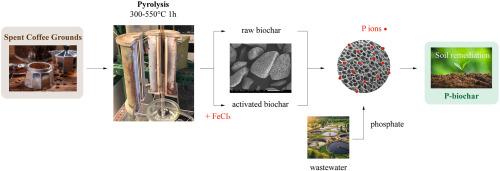Spent coffee ground biochar for phosphate adsorption in water: Influence of pyrolysis temperature and iron-coating activation method
IF 5.3
Q2 ENGINEERING, ENVIRONMENTAL
引用次数: 0
Abstract
A substantial portion of the phosphorus utilized in crop and food production is dispersed into soil and water, posing a challenge to the management of eutrophication and sustainable nutrient recovery. This research focuses on the reclamation of phosphate from polluted water through affinitive adsorption on biochar derived from spent coffee grounds (SCG). SCG were subjected to pyrolysis within a N2-purged vertical furnace across a temperature range of 300–550 °C, with a 1-h holding time. The adsorption capability of SCG biochar was systematically investigated and experimental data were interpreted using Langmuir and Freundlich isotherm models. Notably, the biochar pyrolyzed at 450 °C and activated with a Fe/biochar mass ratio of 2:1 demonstrated the highest adsorption capacity (0.87 mg P/g biochar) when exposed to the highest initial phosphate concentration in the solution (15 mg P/L). Comparative analyses revealed that the removal efficiency of non-activated SCG biochar was considerably lower (5.7%) compared to the corresponding activated biochar (up to 17.3%). This highlights the significant increase in adsorption capacity facilitated by the introduction of ferric chloride. Furthermore, phosphate desorption experiments were conducted to assess the biochar's phosphorus release characteristics and stability. The results demonstrate the positive outcomes of upcycling SCG waste material as a pollutant sorbent and the potential to diminish reliance on chemical fertilizers through the recovery of Fe-phosphate-enriched SCG biochar.

用于吸附水中磷酸盐的咖啡渣生物炭:热解温度和铁涂层活化方法的影响
农作物和粮食生产中使用的磷有很大一部分散失到土壤和水中,给富营养化管理和可持续养分回收带来了挑战。本研究的重点是通过在废咖啡渣(SCG)制成的生物炭上进行亲和吸附来回收污染水中的磷酸盐。咖啡渣在氮气净化的立式炉中进行热解,温度范围为 300-550°C,保温时间为 1 小时。系统研究了 SCG 生物炭的吸附能力,并使用 Langmuir 和 Freundlich 等温线模型解释了实验数据。值得注意的是,当溶液中磷酸盐的初始浓度最高(15 mg P/L)时,在 450 °C 下热解并以 2:1 的铁/生物炭质量比活化的生物炭的吸附能力最高(0.87 mg P/g 生物炭)。比较分析表明,与相应的活性生物炭(高达 17.3%)相比,非活性 SCG 生物炭的去除效率要低得多(5.7%)。这说明氯化铁的引入大大提高了吸附能力。此外,还进行了磷酸盐解吸实验,以评估生物炭的磷释放特性和稳定性。研究结果表明,将氯化石蜡废料作为污染物吸附剂进行升级再循环具有积极意义,而且通过回收富含磷酸铁的氯化石蜡生物炭,有可能减少对化肥的依赖。
本文章由计算机程序翻译,如有差异,请以英文原文为准。
求助全文
约1分钟内获得全文
求助全文
来源期刊

Cleaner Engineering and Technology
Engineering-Engineering (miscellaneous)
CiteScore
9.80
自引率
0.00%
发文量
218
审稿时长
21 weeks
 求助内容:
求助内容: 应助结果提醒方式:
应助结果提醒方式:


